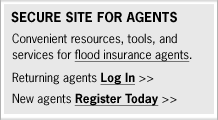
When a community chooses to join the NFIP, it must adopt and enforce minimum floodplain management standards for participation.
"Floodplain management" refers to an overall community program of corrective and preventive measures for reducing future flood damage. These measures generally include zoning, subdivision, or building requirements, and special-purpose floodplain ordinances.
FEMA works closely with state and local officials to identify flood hazard areas and flood risks. Floodplain management requirements within high-risk areas, known as Special Flood Hazard Areas (SFHAs), are designed to prevent new development from increasing the flood threat and to protect new and existing buildings from anticipated flood events.
Communities participating in the NFIP must require permits for all development in the SFHA. Permit files must contain documentation to substantiate how buildings are actually constructed. The community must also ensure that construction materials and methods used will minimize future flood damage.
In return, the federal government makes flood insurance available for almost every building and its contents within the community.
Read more about floodplain management requirements on the FEMA.gov/NFIP Web site.




500 C Street SW, Washington, D.C. 20472
Disaster Assistance: (800) 621-FEMA, TTY (800) 462-7585
U.S. Department of Homeland Security
FEMA Home | Contact FEMA |
Privacy Policy | Important Notices |
FOIA | USA.gov | DHS
